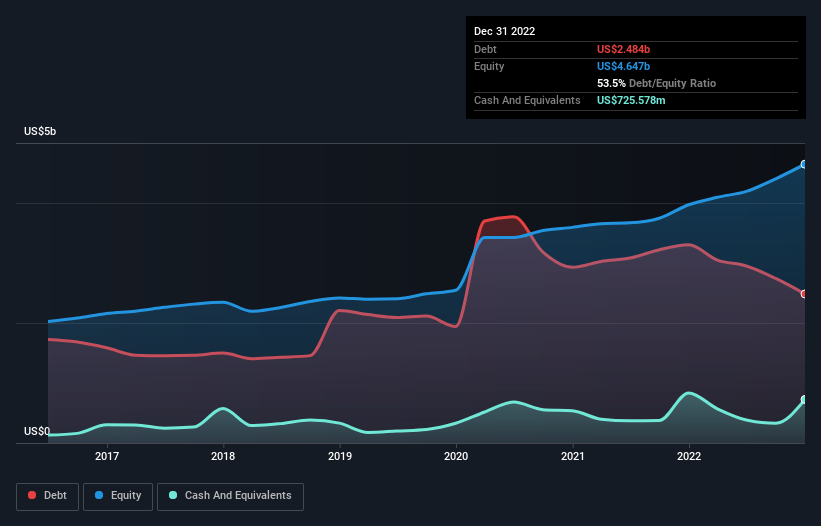- United States
- /
- Consumer Durables
- /
- NYSE:TMHC
We Think Taylor Morrison Home (NYSE:TMHC) Can Stay On Top Of Its Debt

The external fund manager backed by Berkshire Hathaway's Charlie Munger, Li Lu, makes no bones about it when he says 'The biggest investment risk is not the volatility of prices, but whether you will suffer a permanent loss of capital.' When we think about how risky a company is, we always like to look at its use of debt, since debt overload can lead to ruin. We can see that Taylor Morrison Home Corporation (NYSE:TMHC) does use debt in its business. But the more important question is: how much risk is that debt creating?
When Is Debt Dangerous?
Debt is a tool to help businesses grow, but if a business is incapable of paying off its lenders, then it exists at their mercy. If things get really bad, the lenders can take control of the business. While that is not too common, we often do see indebted companies permanently diluting shareholders because lenders force them to raise capital at a distressed price. Of course, debt can be an important tool in businesses, particularly capital heavy businesses. When we think about a company's use of debt, we first look at cash and debt together.
See our latest analysis for Taylor Morrison Home
How Much Debt Does Taylor Morrison Home Carry?
As you can see below, Taylor Morrison Home had US$2.48b of debt at December 2022, down from US$3.30b a year prior. On the flip side, it has US$725.6m in cash leading to net debt of about US$1.76b.

How Healthy Is Taylor Morrison Home's Balance Sheet?
The latest balance sheet data shows that Taylor Morrison Home had liabilities of US$1.24b due within a year, and liabilities of US$2.58b falling due after that. Offsetting these obligations, it had cash of US$725.6m as well as receivables valued at US$191.5m due within 12 months. So it has liabilities totalling US$2.91b more than its cash and near-term receivables, combined.
This is a mountain of leverage relative to its market capitalization of US$4.15b. This suggests shareholders would be heavily diluted if the company needed to shore up its balance sheet in a hurry.
We measure a company's debt load relative to its earnings power by looking at its net debt divided by its earnings before interest, tax, depreciation, and amortization (EBITDA) and by calculating how easily its earnings before interest and tax (EBIT) cover its interest expense (interest cover). Thus we consider debt relative to earnings both with and without depreciation and amortization expenses.
Taylor Morrison Home has a low net debt to EBITDA ratio of only 1.2. And its EBIT covers its interest expense a whopping 83.7 times over. So we're pretty relaxed about its super-conservative use of debt. In addition to that, we're happy to report that Taylor Morrison Home has boosted its EBIT by 67%, thus reducing the spectre of future debt repayments. There's no doubt that we learn most about debt from the balance sheet. But ultimately the future profitability of the business will decide if Taylor Morrison Home can strengthen its balance sheet over time. So if you want to see what the professionals think, you might find this free report on analyst profit forecasts to be interesting.
But our final consideration is also important, because a company cannot pay debt with paper profits; it needs cold hard cash. So we always check how much of that EBIT is translated into free cash flow. During the last three years, Taylor Morrison Home generated free cash flow amounting to a very robust 88% of its EBIT, more than we'd expect. That positions it well to pay down debt if desirable to do so.
Our View
Taylor Morrison Home's interest cover suggests it can handle its debt as easily as Cristiano Ronaldo could score a goal against an under 14's goalkeeper. But, on a more sombre note, we are a little concerned by its level of total liabilities. Zooming out, Taylor Morrison Home seems to use debt quite reasonably; and that gets the nod from us. After all, sensible leverage can boost returns on equity. When analysing debt levels, the balance sheet is the obvious place to start. However, not all investment risk resides within the balance sheet - far from it. For example, we've discovered 2 warning signs for Taylor Morrison Home (1 makes us a bit uncomfortable!) that you should be aware of before investing here.
When all is said and done, sometimes its easier to focus on companies that don't even need debt. Readers can access a list of growth stocks with zero net debt 100% free, right now.
Valuation is complex, but we're here to simplify it.
Discover if Taylor Morrison Home might be undervalued or overvalued with our detailed analysis, featuring fair value estimates, potential risks, dividends, insider trades, and its financial condition.
Access Free AnalysisHave feedback on this article? Concerned about the content? Get in touch with us directly. Alternatively, email editorial-team (at) simplywallst.com.
This article by Simply Wall St is general in nature. We provide commentary based on historical data and analyst forecasts only using an unbiased methodology and our articles are not intended to be financial advice. It does not constitute a recommendation to buy or sell any stock, and does not take account of your objectives, or your financial situation. We aim to bring you long-term focused analysis driven by fundamental data. Note that our analysis may not factor in the latest price-sensitive company announcements or qualitative material. Simply Wall St has no position in any stocks mentioned.
About NYSE:TMHC
Taylor Morrison Home
Operates as a public homebuilder in the United States.
Undervalued with excellent balance sheet.

